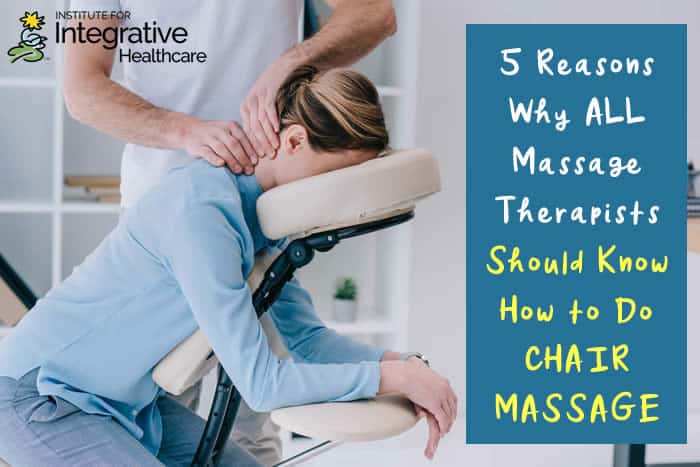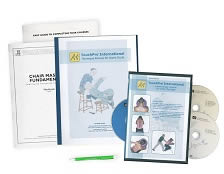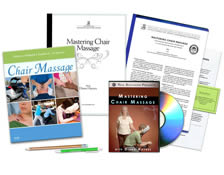

What Is Chair Massage Therapy?
As the name implies, chair massage therapy is massage that is performed with the client seated in a chair. Seated massage is hardly new: “Centuries-old Japanese block prints illustrate people, having just emerged from a nearby bath, receiving massage while seated on a low stool” (1).
But it wasn’t until 1984 that chair massage as it’s practiced today began to take shape. That was the year that David Palmer, director of the Amma Institute of Traditional Japanese Massage in San Francisco, began working with a French cabinetmaker named Serge Bouyssou to design a chair that was portable, would hold a client’s entire body, and allow a massage therapist easy access to the client (1).
3 Problems Chair Massage Solves
The massage chair, as conceived by Palmer, was a way to solve several problems confronting the profession of massage at the time.
- First, the fact that massage chair clients would be fully clothed and in a public area avoided the prevalent association between massage and prostitution.
- Second, because the chair would be portable, it could be brought to any location where potential clients might be.
- And, finally, because the length of the massage could be shortened, the cost would be affordable for those who might be interested in trying massage but weren’t willing to invest a lot of money in doing so.
Since 1986, when Living Earth Crafts in California began manufacture of the first massage chairs, chair massage has grown steadily. By 1998, the demand for chair massage had grown to the point that 20 different companies had produced more than a hundred thousand massage chairs (1).
The American Massage Therapy Association doesn’t keep statistics on product sales and manufacture, and isn’t aware of anyone who does (R. Precht, AMTA, personal communication, August 8, 2019), but I think it’s fairly safe to assume that the numbers have increased substantially since 1998.
What Are the Benefits of a Chair Massage?
In addition to the ancillary—but not insignificant—benefits of the convenience and reduced cost of a chair massage, there are numerous physiological and psychological benefits as well. Research has shown that a 10- or 15-minute chair massage can afford clients many of the same benefits they’d get from a table massage.
10 Benefits of Chair Massage
- Reduced stress and lower blood pressure
- Reduced anxiety
- Reduced depression
- Improved sleep quality
- Decreased duration of musculoskeletal ache, pain, or discomfort
- Increased range of motion
- Improved alertness
- Greater clarity of thinking
- Fatigue reduction
- Greater sense of well-being
As a side note, stress and anxiety are sometimes conflated, but they are, in fact, two different things. “Stress is a response to an external cause, such as a tight deadline at work” (12), while anxiety is a person’s reaction to stress (12).
Once the situation causing stress is resolved, the stress dissipates, whereas anxiety, with its feelings of apprehension and dread, can persist even when a situation is not threatening in any way.
Massage, as stated above, can be helpful in reducing both.
What Should Someone Wear to a Chair Massage?
Though chair massage, owing to its portable nature, has popped up everywhere from airports and malls to corporate offices and medical settings, it may still be foreign to some clients. Consequently, they may wonder what they should wear to receive a chair massage.
Here are a few things you may want to suggest to a client new to chair massage:
- Don’t wear clothing that’s restrictive or tight. When you are seated in the massage chair, you want to be able to bend comfortably forward as you lean into the face cradle and you will need to bend your legs to sit in the chair. Also, the therapist may want to reposition your arms for various techniques, so you don’t want anything that will restrict your arm movement (13).
- Don’t wear anything too bulky. If you’re at work, and you need to wear a suit jacket or if you are wearing a sweater, take them off before you get on the chair. The thicker the material you put between your skin and the therapist’s hands, the less effective the massage may be. Thinner fabrics will also allow the therapist to locate tight muscles more easily (13, 14).
- Remove jewelry before the massage. Not only might it be uncomfortable if your earrings or necklace are pressed into you by the chair, jewelry might also restrict the therapist from working freely on your head, neck, arms, and shoulders (13). If you do wear jewelry on the chair and it is getting in the way, the therapist might have to interrupt the session to ask you to take them off—which could interrupt the relaxation process (14).
- Skirts are OK as long as the “the hem comes to within 6 inches of your knees when you are standing, and you can comfortably stand with your feet shoulder width apart” (13). These caveats are to ensure that you can move freely enough to get seated on the massage chair and do so without exposing yourself more than you might want.
- Avoid excessive hair products. One of the most stress-relieving techniques a therapist can offer is scalp massage. If you are wearing a lot of hair product, the therapist will have trouble moving his or her hands through your hair. This could result in your hair being pulled in a way that causes discomfort (14). Wearing a wig, hat, or scarf will also prevent you from being fully able to enjoy a chair massage. If you don’t want your head massaged, be sure to let the therapist know that.
These are a few of the things you may wish to suggest to a client new to chair massage. You may think of other things as you go along. A belt, for example, might get in the way if someone asks to have you work on their lower back or hips.
Chair Massage Techniques
When David Palmer first began considering chair massage as a way to introduce massage to a larger audience, he was using amma, a traditional form of Japanese massage that uses percussive manipulations, pressing, stroking, and stretching through clothing and without the use of oil (15, 16). The most commonly used techniques now are deep friction, effleurage, and compression (17), but petrissage and tapotement are also useful techniques when working on a fully clothed client.
Mary Kathleen Rose, in her article “Seated Massage,” suggests that acupressure and other forms of compression techniques especially lend themselves to chair massage because they work well with clients who are fully clothed (18). Rose advises using broad compression to warm the muscles first before applying deeper, more precise compression such as with a thumb or elbow (18). As you apply more pressure, be sure to ask the client for feedback and watch for nonverbal cues.
If you are new to providing chair massage and would find a suggested routine helpful, see Ralph Stephens’s chapter on seated massage in Massage Therapy: Principles and Practice (17).
Why Should Massage Therapists Know How to Do Chair Massage?
There are many reasons why doing chair massage can be a valuable asset to your practice.
Below are 5 important ones you really need to know about.
1. Chair massage is a great way to promote massage generally.
People who are wary of massage because of the expense or for fear of being undressed alone in a room with a stranger can experience the benefits of massage inexpensively and fully clothed in a public space (1). That experience—along with, perhaps, the suggestion that a table massage might be valuable for further work on a specific issue (19)—may be enough to convince those formerly reluctant to consider a table massage.
2. Chair massage can provide you with a way to promote your own business.
In addition to benefiting the massage industry as a whole, you can arrange with nearby companies, malls, conventions, or sporting events to let you do chair massage for a specific event or at a specified time. Most often, with the permission of the venue you are working for, you can hand out your business card or at least have cards out for people to take.
The trick to make this kind of arrangement is to be able to delineate how chair massage will benefit the business in question, whether that benefit is making a company’s employees more alert and productive (6, 9, 20) or that you will help customers linger longer at the mall.
Sometimes payment will come directly from the venue’s management, sometimes individual massage recipients will pay, and sometimes you will volunteer your services in hopes that time spent there will generate new business for you.
3. In addition to reaching potential clients one at a time, you can also use chair massage to do creative marketing.
There is the potential, for instance, for offering chair massages to local TV and radio stations and newspapers in exchange for free advertising (20).
4. Chair massage is a way to have a positive impact on many people in a short amount of time.
5. And, finally, offering chair massage as part of your business practice, in addition to table massage, builds variety into your work (22), with opportunities for you to use different postures and different skill sets.













